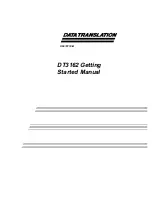
Chapter 5
Calibration
5-4
www.natinst.com
write to the current offset channel will be close to 10 µA, and increasing it
will lower the current you measure.
Gain Adjustment
To calibrate the gain, set the current output channel to a current near
full-scale, such as 20 mA. Then, change the current gain channel value
until the output that you measure is as close as possible to the current that
you wrote to the output channel. The current you write to the current gain
channel will be close to 19.608 mA, and increasing it will lower the current
you measure.
You can also calibrate using several output channels instead of just one by
adding channels together. Do this by writing the values to all the channels
you wish to add and summing the outputs by connecting them together.
This will reduce the sensitivity of the calibration process to interchannel
mismatch—the slight differences in the output characteristics of the
channels by averaging out these differences.
Saving Calibration Values
When you have finished calibration, you will want to write your calibration
values into nvRAM. This will ensure that your new calibration values are
permanently saved and automatically loaded when the card is powered-on.
Calibration values are saved and restored through the
AO_Calibrate
(
deviceNumber
,
operation
,
EEPROMloc
) function call in NI-DAQ. To
save your calibration values, make the following call:
AO_Calibrate
(
deviceNumber
, 2, 1), where
deviceNumber
refers to the device number
assigned by the NI-DAQ Configuration Utility. If you need to restore the
factory calibration values, load them by calling
AO_Calibrate
(
deviceNumber
, 1, 5). For more information, consult the
NI-DAQ
Function Reference Manual
.
















































